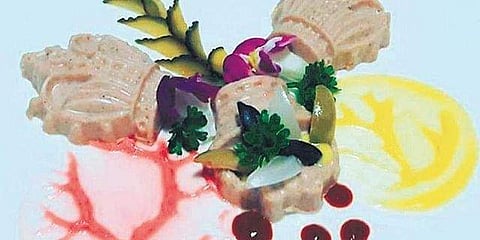
- LIFESTYLE
- FASHION
- FOOD
- ENTERTAINMENT
- EVENTS
- CULTURE
- VIDEOS
- WEB STORIES
- GALLERIES
- GADGETS
- CAR & BIKE
- SOCIETY
- TRAVEL
- NORTH EAST
- INDULGE CONNECT

If you’ve dined at a high-end restaurant, you’re probably familiar with the concept of being served bite-sized appetisers before your order arrives. If you haven’t, don’t be surprised when these cute-looking and yummy-tasting things are served at some not-so-big restaurants soon.
Called amuse-bouche, it simply attempts to do what it says — amuse the mouth. A thing of the West, it had made inroads into India decades ago, but was confined to fine-dining restaurants until now, say chefs in the city. Explaining what amuse-bouche is, chef Cyril Clement, Regency College of Culinary Arts & Hotel Management, Hyderabad, says, “It’s a small portion of food served before your actual order arrives. This is a practice you see most commonly in fine-dining restaurants. The basic purpose that amuse-bouche serves is giving the customer a small idea of what is to come from the chef, in the form of their main course.”
Cyril breaks down the process of preparing an amuse-bouche. “It generally takes time to cook and serve fresh food, so the chef takes a tiny slice of whatever is being prepared. For example, if the customer has ordered something to do with lamb, the chef takes a small portion of the lamb and adds to it a few ingredients and sends it to diners.” What was once restricted to fine dining alone, is now gradually growing beyond that. South Indian-fusion restaurant Anna Native in Sainikpuri has been serving its customers amuse-bouche, but a sweet one. Called Balushahi, the tiny sweet is made of ghee and has left Hyderabadis wanting for more! Mohd Ismail, the executive chef, says people often mistake it to be a starter but it’s not.
He explains the difference: “Amuse-bouche is different from starters; it’s not asked for by the customer and is not part of the menu. So, the customer is also not billed for it.” He goes on to add, “In simple terms, it’s like the chef giving you a trailer or a teaser of what you can expect from him as he prepares your food.”Giving us insight into its history, chef Mohit Mishra, executive chef at Taj Deccan, says, “Amuse-bouche is a French concept that came into existence around the 80s. It became a culture of the West and several big hotels in India have been riding high on this for years now.”
On how chefs curate and decide on an amuse-bouche, he says, “They are served at the start of the meal and go in accordance with a particular theme or menu curated for VIP guests or sit-downs. If it’s a traditional South Indian restaurant, it could serve mini vadas or button idlis. If it’s a North Indian themed-restaurant, papdi-chaat could be served. If it’s Japanese, bite-sized sushi could come your way.”
Another good thing about an amuse-bouche is that restaurants don’t have to stick to keeping it only savoury or sweet. Mohit says, “Some places serve watermelon scoops, tarts and vol-au-vents, depending on the kind of food you’ve ordered. Also, it’s not just about food, it can be drinks, with alcoholic or non-alcoholic shooters, such as celery or ginger carrot shots.”
On what goes into making this, he says, “All this is done while retaining the authentic flavours of the dish. Even though they come in the size of a small spoon, a lot of work goes into making these little bites. The chef needs to figure the right ingredients in the proportions while also working on presenting them well. For example, a vada amuse-bouche must have all the elements of the vada itself — the chutney and maybe even the podi.”